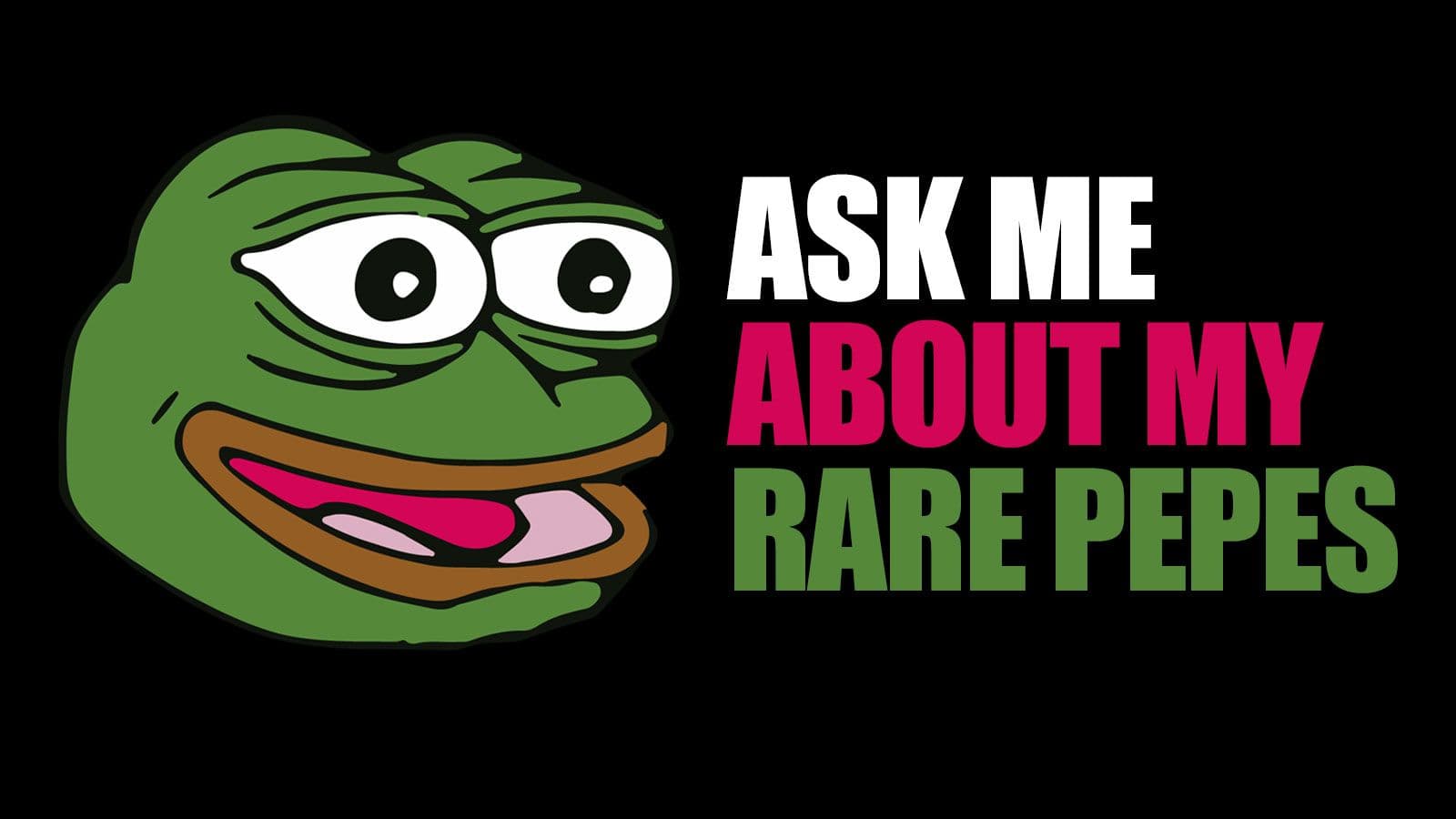From early experiments like Bitcoin Colored Coins in 2012, the perceived value of NFTs has grown exponentially. Yet despite this surge in trading volume and adoption, numerous collections continue to be shaped by the mercurial market — rapidly rising and falling under the influence of celebrity endorsements.
Understandably, this volatility leaves many wondering how to identify assets that are not merely speculative vaporware or cultural fads. Some seasoned collectors, however, remain steadfast in their convictions, valuing “historical” assets from the 2015–2017 era more than recent mints or open editions, believing they have demonstrated lasting significance (so to speak).
These tokenized artifacts, which include projects like Spells of Genesis (2015) and Etheria (2015), embed provenance and nostalgia within Bitcoin and Ethereum’s perennial landscape of decentralized wonders. Similarly, Rare Pepes (2016) set a key precedent by demonstrating that digital collectibles could accrue value based purely on cultural resonance and scarcity without needing built-in utility like gameplay functions or passive rewards. In doing so, they helped lay the foundations for what would later be dubbed the CryptoArt movement.
A group of innovators known as the Rare Pepe Scientists also achieved several major firsts through the memetic digital frog and the permissionless nature of its underlying blockchain (Bitcoin). A few notable milestones include:
• Immutable Community Art and the Pepechain: the first CryptoArt community to freely buy, sell, swap, and destroy NFTs, with images permanently tied to the blockchain (CHYNAPEPE).
• SCHROEPEPE: the first NFT to dynamically change its appearance.
• DJPEPE, PEPEBALT: the first NFTs to integrate songs and games into tokens.
• Opendime, Satellites, and NFC Chips: the first NFTs to be transferred and stored on physical devices (an NFC chip) and broadcast from a satellite.
(Note: The term “NFT” didn’t exist when Rare Pepes started in 2016. It’s mentioned in this article just as a helpful reference).
Immutability
Contrary to what many might assume, given the way “non-fungible” has been interpreted in popular discourse, parts of an NFT, such as the image or metadata, can be changed if they aren’t fully stored on-chain. Several factors, like centralized hosting or reliance on marketplaces to pay IPFS data fees, can result in the loss of associated art, video, or music if the creator or platform shuts down, goes bankrupt, or simply stops maintaining the files.
The Rare Pepe community recognized and addressed these issues as early as 2016 with CHYNAPEPE, often credited as the first immutable artwork on a blockchain.
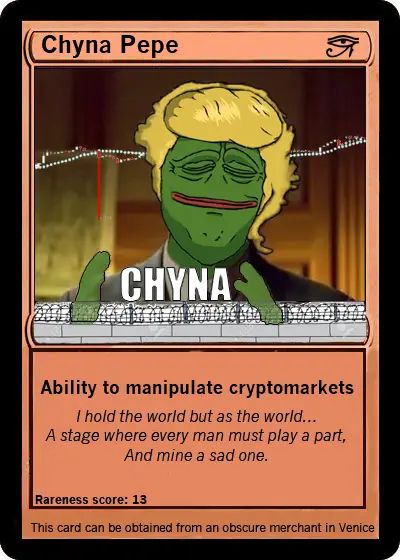
Chyna Pepe released October 2016 by Cryptonati
Creators Goat and Bench solved the problem of NFT mutability by embedding the MD5 hash of the original Chyna Pepe image directly into the token’s description field. You can view it here: https://xchain.io/asset/CHYNAPEPE
To clarify:
Any digital image, (a string of numbers or sequence of data), can be used to produce a unique cryptographic hash. No two images, even if nearly identical, will generate the same hash. Each image has a unique MD5 hash or fingerprint, functioning like a digital ID.
With this in mind, verifying the authenticity of a Chyna Pepe is simple:
- Upload the respective image to a site like onlinemd5.com
- The site will generate a hash based on the image
- If this hash matches the one published by Goat and Bench, the asset and image is authentic

The MD5 “checksum” hash can be found in the description field on xchian.io
https://www.youtube.com/watch?v=nofo90f7V7A&t=3s
Pepechain
But MD5 hashes aren’t perfect. Acknowledging this, developer Joe Looney launched Pepechain on October 22, 2016, to offer the public a more reliable way to secure and verify their Rare Pepes.
As explained in a related Medium article, Pepechain enhances authenticity by using a Merkle tree of SHA-256 hashes. In essence, Pepechain links the hashes of all verified images together through a single “root” hash, creating a cryptographic structure where each asset is connected to a unified, tamper-proof reference. It also includes a downloadable script that collectors can use to cross-reference and verify assets against the official Rare Pepe Directory.
Put more simply, Pepechain takes all the verified images and ties them together using one master code, like linking them on a single digital chain. This makes it easy to confirm that each image is authentic and hasn’t been altered. The included script allows collectors to easily check any image against the official Rare Pepe Directory.
The Rare Pepe Wallet:
Before the Emblem Vault, storing Rare Pepes was only possible through wallets congruent with the Bitcoin blockchain, such as the “Rare Pepe Wallet.” In addition to serving as an encrypted storage solution, the wallet also enables traders and collectors to use PepeCash as a medium of exchange.
Joe Looney Interview:
As the creator of the Rare Pepe Wallet and a key contributor to the ever-expanding Pepe-verse, it was only fitting to get Joe’s thoughts on the collection, its origins, its impact and where it might be headed.
SCHROEPEPE
The SCHROEPEPE card, inspired by Schrödinger’s cat, was released in 2017. Its creative process and initial ideation, however, began nearly two years earlier, around September 2015. During that time, the pseudo-anonymous artist Gilles (known by his Twitter handle @netindexed) started experimenting with digital artworks that leveraged a PNG rendering exploit. He later refined the idea by creating a proof of existence using the file’s SHA-256 hash.
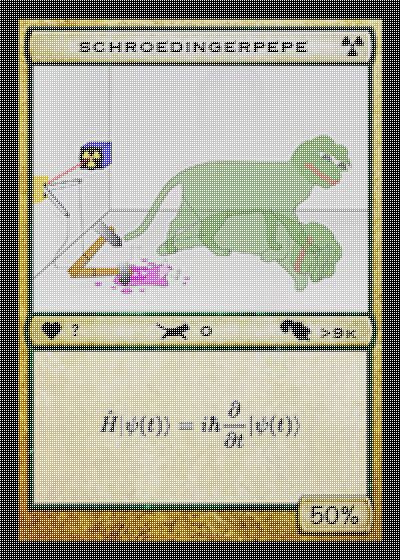
SCHROEPEPE released April 2017 by netidx
Upon discovering Rare Pepes, Gilles noticed that although the tokens were on the Bitcoin blockchain, many of the linked images were still centrally hosted and could be altered or removed. Playing off this errancy, he created SCHROEPEPE using a .png file that changes the card’s appearance (Pepe dead or alive) depending on the software or device used to display it.
Gilles explained that this unique use of renderers also mirrors how people’s perceptions can shift based on their cultural context and environment.
There’s no official list of programs that support the PNG gamma settings, but the card’s full visual effect is most noticeable when viewed in Safari. Firefox and Chrome don’t display any variation. In some applications, scaling the image can cause the file to glitch and reveal both versions of the card simultaneously.
Given the layered complexity and conceptual depth of SCHROEPEPE, much of its significance may be lost on those unfamiliar with the nuances of Rare Pepes. The following interview with Gilles offers a deeper look into his creative process and the ideas that shaped his work.
DJPEPE (VIP MUSIC):
With over 1,700 individual cards across 36 different series, the open nature of Rare Pepes gave rise to a number of community-driven initiatives. Among these are games like PepeBalt and the notable DJPEPE — a full-production music NFT created through a collaboration between Rare Scrilla and Joe Looney.
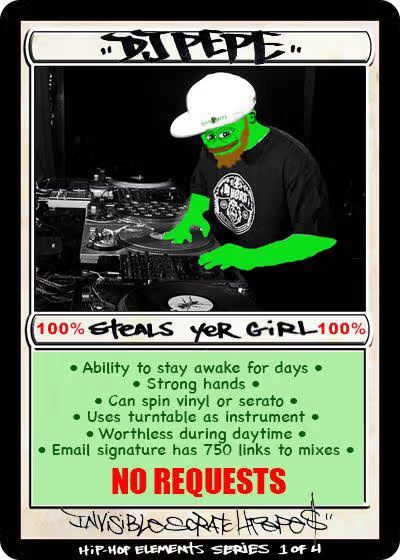
DJPEPE released October 2016 by Rare Scrilla
Much like how some NFTs grant access to gated Discord servers, DJPEPE is designed to unlock exclusive content. By verifying ownership of the token through an API, holders receive a non-shareable link, masked and tied to their device, which grants access to Scrilla’s private SoundCloud library.
The DJPEPE character, a life-sized cardboard cutout, also made an appearance at the first live CryptoArt and music auction: the Rare Digital Art Festival (known as Rare AF, or Rare as Fuck) in 2018. It was at this event that the 1/1 Homer Pepe famously sold for $39,000, or around 350,000 PepeCash.
PEPEBALT:
Created by the late John Villarz in 2017, another core contributor to the Rare Pepe community, PEPEBALT is the first video game built into a Rare Pepe card. Holders can access the micro-game by clicking on Bonus Content inside the Rare Pepe Wallet. The gameplay is simple: tap the spacebar to jump over spikes. Only 600 NFTs were ever issued.
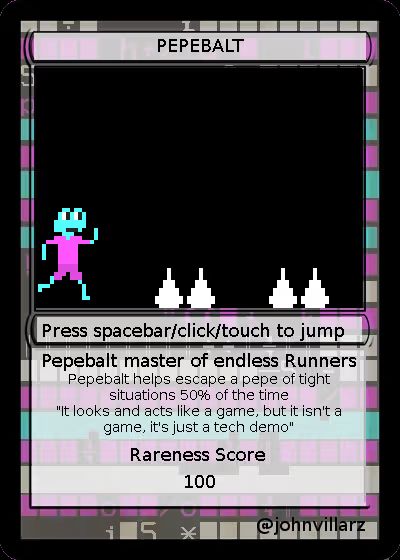
Opendime:
While Rare Pepes were initially celebrated as digital collectibles, they also made an early leap into the physical world in 2017 via Opendime - a small USB stick that allows Bitcoin (BTC) to be transferred off-chain, similar to handing someone a dollar bill.
Because Counterparty is compatible with Bitcoin addresses, no special formatting is needed to send assets like Rare Pepes to an address generated by Opendime. And since the private keys are stored only on the device itself, people can freely trade or sell these assets without compromising their finite and immutable nature.
This playful yet technically sound innovation was driven by @mikeinspace, a self-proclaimed enthusiast of crypto novelty. His work has ranged from storing Rare Pepes on satellites and NFC chips to embedding one inside an Opendime keychain modeled after the PEPEGOTCHI card.
The following interview offers deeper insight into his inspiration, methodology, and perspective on the collection.
Conclusion:
While the size of the Rare Pepe collection may deter some buyers, and its visibility has been eclipsed in recent years by projects like CryptoPunks, it remains a foundational force in the NFT ecosystem. Far from being forgotten, Rare Pepes are celebrated not just for their historical significance but for the culture they sparked - an irreverent, decentralized, and meme-powered art movement built by anonymous artists, technologists and crypto patrons alike.
In this light, beyond just the art itself, Rare Pepes offered developers and creators a functional foundation to build upon. Technically, they demonstrated that digital assets could be unique, irreplaceable, and enduring. As long as Bitcoin exists, Rare Pepes will continue to reflect a pivotal moment in digital history when a grassroots community figured out how to create culturally resonant, cryptographically scarce art for the world.
Or, as Joe Looney aptly put it: “The token is the art.”


